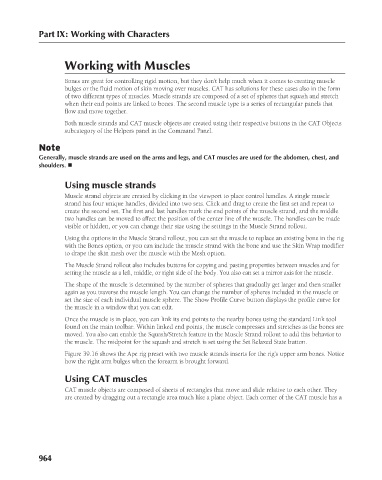Page 1012 - Kitab3DsMax
P. 1012
Part IX: Working with Characters
Working with Muscles
Bones are great for controlling rigid motion, but they don’t help much when it comes to creating muscle
bulges or the fluid motion of skin moving over muscles. CAT has solutions for these cases also in the form
of two different types of muscles. Muscle strands are composed of a set of spheres that squash and stretch
when their end points are linked to bones. The second muscle type is a series of rectangular panels that
flow and move together.
Both muscle strands and CAT muscle objects are created using their respective buttons in the CAT Objects
subcategory of the Helpers panel in the Command Panel.
Note
Generally, muscle strands are used on the arms and legs, and CAT muscles are used for the abdomen, chest, and
shoulders. n
Using muscle strands
Muscle strand objects are created by clicking in the viewport to place control handles. A single muscle
strand has four unique handles, divided into two sets. Click and drag to create the first set and repeat to
create the second set. The first and last handles mark the end points of the muscle strand, and the middle
two handles can be moved to affect the position of the center line of the muscle. The handles can be made
visible or hidden, or you can change their size using the settings in the Muscle Strand rollout.
Using the options in the Muscle Strand rollout, you can set the muscle to replace an existing bone in the rig
with the Bones option, or you can include the muscle strand with the bone and use the Skin Wrap modifier
to drape the skin mesh over the muscle with the Mesh option.
The Muscle Strand rollout also includes buttons for copying and pasting properties between muscles and for
setting the muscle as a left, middle, or right side of the body. You also can set a mirror axis for the muscle.
The shape of the muscle is determined by the number of spheres that gradually get larger and then smaller
again as you traverse the muscle length. You can change the number of spheres included in the muscle or
set the size of each individual muscle sphere. The Show Profile Curve button displays the profile curve for
the muscle in a window that you can edit.
Once the muscle is in place, you can link its end points to the nearby bones using the standard Link tool
found on the main toolbar. Within linked end points, the muscle compresses and stretches as the bones are
moved. You also can enable the Squash/Stretch feature in the Muscle Strand rollout to add this behavior to
the muscle. The midpoint for the squash and stretch is set using the Set Relaxed State button.
Figure 39.16 shows the Ape rig preset with two muscle strands inserts for the rig’s upper arm bones. Notice
how the right arm bulges when the forearm is brought forward.
Using CAT muscles
CAT muscle objects are composed of sheets of rectangles that move and slide relative to each other. They
are created by dragging out a rectangle area much like a plane object. Each corner of the CAT muscle has a
964

